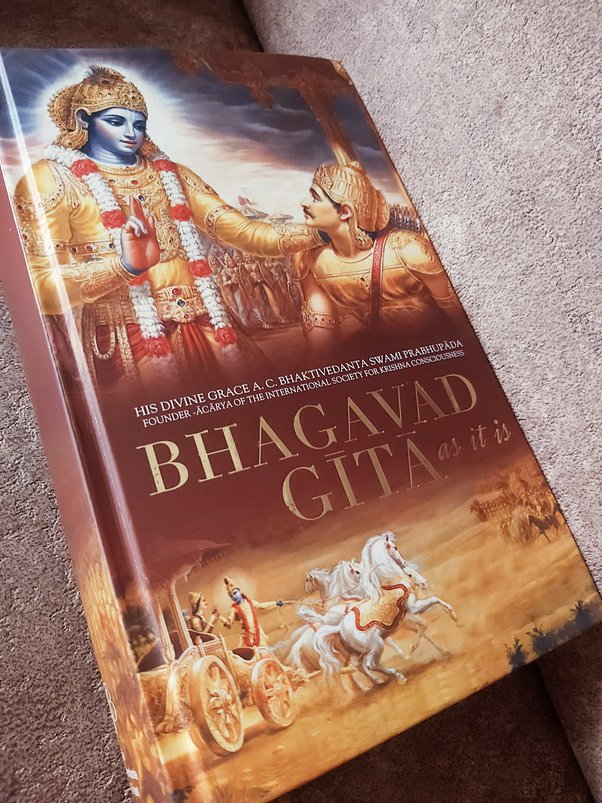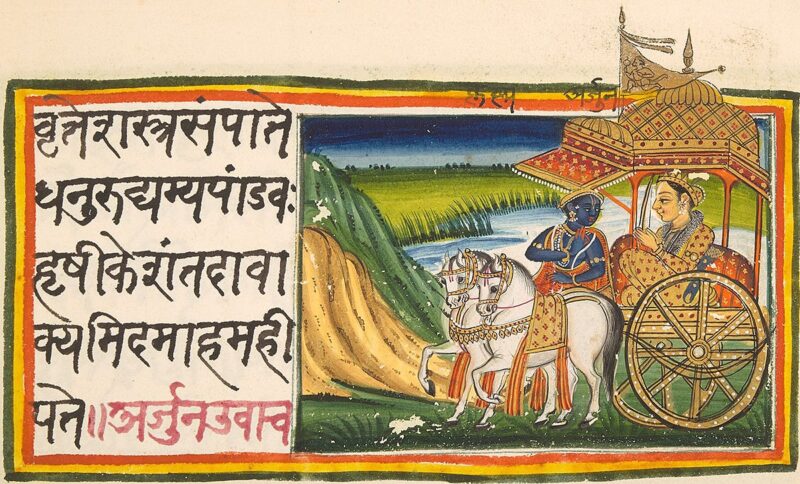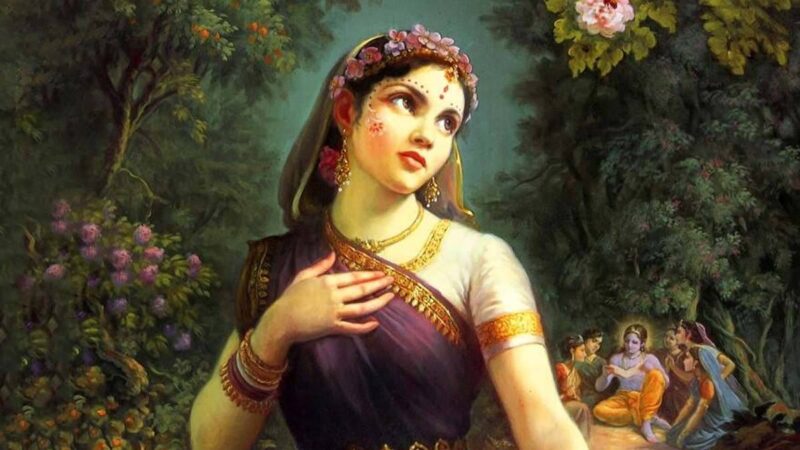The Bhagavad Gita is a sacred scripture that contains the teachings of Lord Krishna to Arjuna on the battlefield of Kurukshetra. It is considered one of the most important texts , as it reveals the essence of Vedanta, the philosophy of self-realization. By studying the Bhagavad Gita, one can gain many benefits, both spiritual and material. In this article , I will discuss ten of these benefits, based on the verses from the Bhagavad Gita itself.
1. Spiritual Benefits
The Bhagavad Gita says that whatever benefits one may get by studying the Vedas, performing sacrifices, practicing austerity, and giving charity, one can surpass them all by simply studying the Bhagavad Gita (BG 8.28). This is because the Bhagavad Gita reveals the supreme goal of life, which is to attain the love of God.
2. Universal Accessibility
The Bhagavad Gita is not meant for a particular class or caste of people, but for everyone who is interested in the truth. The Bhagavad Gita declares that even the most sinful, low-born, or unqualified person can attain the highest perfection by taking shelter of Krishna. (BG 9.32). Therefore, anyone, regardless of their gender, occupation, or background, can read the Bhagavad Gita and benefit from its teachings. The Bhagavad Gita is also easy to understand, as it is written in the form of a dialogue between Krishna and Arjuna, and covers various topics such as karma, dharma, yoga, reincarnation, liberation, and devotion.
3. Connection and Protection
The Bhagavad Gita teaches us how to connect with Krishna, the source of all happiness, through the process of bhakti-yoga, or loving service. By reading the Bhagavad Gita, we can learn how to offer our actions, words, and thoughts to Krishna, and thus become free from the bondage of material existence. When we are in touch with Krishna, He protects us from falling down or breaking our connection with Him. He helps us to maintain our devotion and gives us the highest love, which we do not have (BG 9.22). In other words, Krishna guides and nurtures us as a friend, a father, a mother, and a lover.
4. Perseverance and Inspiration
The Bhagavad Gita assures us that Krishna’s devotees will never perish, even if they commit some mistakes or face some difficulties in their spiritual path. This means that nothing can destroy Krishna’s devotee, as He is always with him or her. However, a devotee may go through ups and downs in his or her devotion, but maya, the illusory energy, cannot take the devotee away from Krishna. Krishna protects His devotees from falling down permanently from the platform of bhakti. He gives them inspiration from within and guidance and warnings through His representatives, the guru and the Vaishnavas, so that they do not give up bhakti completely (BG 9.31). Krishna also protects their bhakti from being destroyed by the problems they face in their life and preserves their faith in Him, His names, and His devotees. Otherwise, one may doubt Krishna, the guru, and the Vaishnavas, and leave bhakti.
5. Fearlessness and Wisdom
The Bhagavad Gita enables us to become free from fear and lamentation, which are the causes of misery in this world. Krishna says that a devotee will not lament for the past or worry about the future, but will live in the present with full awareness of his or her eternal identity as a soul, part and parcel of Krishna. The devotee will become free from fear of death, disease, old age, and suffering, as he or she knows that these are temporary and do not affect the soul, which is immortal and blissful. By studying the Bhagavad Gita under the guidance of a guru and the Vaishnavas, one can act in the present without fear and lamentation, by learning from the past and planning for the future. One becomes wise and gentle by reading the Bhagavad Gita (BG 18.54).
6. Becoming a dhīra
By reading the Bhagavad Gita one becomesa dhīra, a person who is self-controlled and detached from the material world. A dhīra conquers kāma (lust) and krodha (anger) by controlling his senses and desires. He understands that his body and mind are constantly changing, but he is not, i.e., he is not attached to the body and mind. Because he does not identify himself with the body, he transcends the bodily platform. (BG 2.13).
6. Becoming a sthita-prajña
By reading the Bhagavad Gita one becomesa sthita-prajña, a person who is steady in wisdom and equanimity. A sthita-prajña remains undisturbed in any condition by reading the Bhagavad Gita. Prajña means consciousness and sthita means stable. There is a difference between a dhīra and a sthita-prajña. A dhīra is detached from the body and mind and is free of kāma-vāsana (desire for enjoyment). A sthita-prajña is undisturbed and unaffected by any situation in this world. He is not troubled by any problem in his life. He is almost dead from the world’s perspective. (BG 2.54).
7. Becoming a Pandita
By reading the Bhagavad Gita or following its injunctions, one becomes a paṇdita. A paṇdita has all good qualities, including vinaya (humility), the queen of all good qualities, vidyā (knowledge), or the wisdom of life. He also sees every living entity with an equal vision as part and parcel of Bhagavān (God). He does not discriminate between a good and a bad person and a sinful and pious person. A paṇdita sees that everyone is part and parcel of Bhagavān and tries to bring everyone back to Bhagavān. (BG 5.18).
9. Freedom from Birth and Death
By reading the Bhagavad Gita, one can be freed from the cycle of birth and death forever, if one desires so .Even if one does not desire so, reading the Bhagavad Gita will develop the desire. The Bhagavad Gita teaches that the soul is eternal and indestructible, and that it transmigrates from one body to another according to its karma (actions). However, by surrendering to Bhagavān and following His instructions, one can break the cycle of birth and death and attain His abode, which is beyond the material world. (BG 4.9 and BG 8.16).
10. Becoming Dear to Krishna
The ultimate benefit of reading the Bhagavad Gita is to become dear to Krishna, the supreme object of love. If we become dear to Krishna, it does not matter whether or not we get the other benefits. We practice bhakti for this purpose. This is the main benefit. It is not important whether Krishna is dear to us, but what is more important is if we are dear to Krishna. Therefore, Krishna did not say that He becomes dear to the one who reads the Bhagavad Gita. He said that the one who reads the Bhagavad Gita becomes dear to Him. (BG 12.20).
Conclusion
The Bhagavad Gita is a treasure of wisdom and spirituality that can enrich our lives in many ways. By studying it, we can learn how to control our senses and emotions, how to remain calm and composed in any situation, how to acquire knowledge and humility, howto liberate ourselves from the cycle of birth and death, and how to develop love and devotion for Kṛṣṇa, the supreme goal of life. The Bhagavad Gita is not just a book, but a living guide that can transform our consciousness and lead us to the highest perfection.









